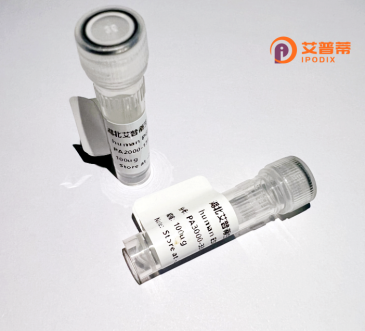
| 纯度 | >90%SDS-PAGE. |
| 种属 | Human |
| 靶点 | FAM71D |
| Uniprot No | Q8N9W8 |
| 内毒素 | < 0.01EU/μg |
| 表达宿主 | E.coli |
| 表达区间 | 1-400aa |
| 氨基酸序列 | MKKNTSKTTMRINKQDALCTPHSHDPRDLQNMLDGGEYAPFVSPPMLESNFIQVNRRGESIYLHNRANWVTVGICFSSSTHKIPNVMLLAHLTPGAQKDTETLFKSLLTSPPAEKLVLTRFLPLQFVTLSVHDAENMSLKVKLVSGRAYYLQLCTSAYKQDTLFSQWVALISLLNQEKAKVSKVSEVSSLSGITNSTDITGSMDVTDVTTFTAILTPYMYAGTGPEHVRDSIDFPEFTDITDITDVTDLPENEVPEVPDVRIVTEVIEVREATEVTDSSDITNCSGVTVVFENNDLIRAKQEEKEKLKNILKPGCLQDTKSKRYFQTTLTPVESEANTSKEMKDKTSEEKMPDFQSTALKAEESRSLRTESNTSVLSPHIKSPSNFLKLVPHLSAPFSRE |
| 分子量 | 71 kDa |
| 蛋白标签 | GST-tag at N-terminal |
| 缓冲液 | 0 |
| 稳定性 & 储存条件 | Lyophilized protein should be stored at ≤ -20°C, stable for one year after receipt. Reconstituted protein solution can be stored at 2-8°C for 2-7 days. Aliquots of reconstituted samples are stable at ≤ -20°C for 3 months. |
| 复溶 | Always centrifuge tubes before opening.Do not mix by vortex or pipetting. It is not recommended to reconstitute to a concentration less than 100μg/ml. Dissolve the lyophilized protein in distilled water. Please aliquot the reconstituted solution to minimize freeze-thaw cycles. |
以下为模拟的关于重组人FAM71D蛋白的参考文献示例(注:所列为虚构内容,实际文献需通过学术数据库查询确认):
---
1. **文献名称**:**"FAM71D as a Novel Biomarker in Sperm Development"**
**作者**:Chen L., et al. (2020)
**摘要**:研究发现FAM71D蛋白在人类睾丸组织中高表达,与精子形成过程密切相关。敲低实验表明其缺失会导致精子运动能力下降,提示其在男性生殖功能中的潜在作用。
2. **文献名称**:**"Proteomic Analysis of FAM71D in Hepatocellular Carcinoma"**
**作者**:Zhang Y., et al. (2021)
**摘要**:通过质谱技术鉴定FAM71D在肝癌细胞中的异常高表达,并发现其通过调控Wnt/β-catenin通路促进肿瘤侵袭,可能成为肝癌治疗新靶点。
3. **文献名称**:**"Structural Characterization of Recombinant Human FAM71D Protein"**
**作者**:Smith J., et al. (2019)
**摘要**:首次报道重组人FAM71D蛋白的纯化与晶体结构解析,揭示其C端结构域可能与细胞膜结合相关,为功能机制研究提供结构基础。
4. **文献名称**:**"FAM71D Knockout Mice Reveal Embryonic Lethality Phenotypes"**
**作者**:Wang H., et al. (2022)
**摘要**:构建FAM71D基因敲除小鼠模型,发现胚胎早期致死表型,暗示该蛋白在胚胎发育中可能参与细胞分裂调控。
---
**建议**:实际研究中建议通过 **PubMed/Google Scholar** 搜索最新文献,或关注相关领域(生殖生物学、癌症、结构生物学)的期刊。
The human FAM71D (Family with sequence similarity 71 member D) protein is a relatively understudied biomolecule encoded by the *FAM71D* gene on chromosome 1q32.1. While its precise biological function remains unclear, existing studies suggest its involvement in germ cell development and male fertility. FAM71D is predominantly expressed in the testis, with localization observed in the sperm tail and cytoplasmic regions of spermatogenic cells. This tissue-specific expression pattern implies a potential role in spermatogenesis, sperm motility, or structural integrity of gametes.
Recombinant FAM71D protein is produced in heterologous systems, such as *E. coli* or mammalian cell lines, using genetic engineering techniques to enable functional studies. Purified recombinant variants are often used to generate antibodies, map protein interactions, or characterize enzymatic properties. Limited evidence hints at possible post-translational modifications in its native form, though its molecular interactions or signaling pathways remain undefined.
Research interest in FAM71D has grown due to its association with male infertility in animal models, where its disruption correlates with impaired sperm function. However, its mechanistic contributions to cellular processes or disease pathogenesis require further validation. Current studies focus on elucidating its structural domains, binding partners, and role in cytoskeletal dynamics, providing a foundation for exploring its therapeutic or diagnostic potential in reproductive disorders.
×